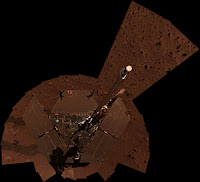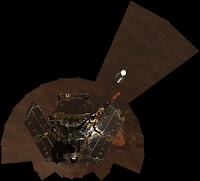 Spirit and Opportunity have been roving on Mars for over a year now, doing lots of great science. Both of them are long past their design lifetime, and are off on extraordinary unplanned exploration. Spirit is climbing some low mountains, hoping for both informative geology and a good view. Opportunity just finished thoroughly exploring a small crater, and after that found it's own heat shield and studied that. It's now off on a long trek across the mostly featureless plains its on, in the hope of making it to another crater.
Spirit and Opportunity have been roving on Mars for over a year now, doing lots of great science. Both of them are long past their design lifetime, and are off on extraordinary unplanned exploration. Spirit is climbing some low mountains, hoping for both informative geology and a good view. Opportunity just finished thoroughly exploring a small crater, and after that found it's own heat shield and studied that. It's now off on a long trek across the mostly featureless plains its on, in the hope of making it to another crater.
Spirit is in pretty good shape, but is suffering from a few problems of old age. For example, it has a "sticky" wheel that sometimes drags a bit. And it has an intermittently shorted wire that is so far not causing any problems, but could. Spirit also has a coating of dust on its solar cells that reduces the amount of power they provide. This dusting of the solar cells was expected, and in fact was something that the mission planners thought was likely to be what finally killed off the rover — but so far, the coating is much less than expected and is not causing major problems. Occasionally the operations planners include relatively quiet days to let Spirit's batteries charge up, but that's about the only impact of the dust.
Opportunity, on the other hand, is surprising everybody. Not only is it still in tip-top shape, but it also inexplicably has far less dust than even Spirit! Also, photo observations have shown that the dust has been somewhat mysteriously cleaned off a few times during Opportunity's travels. Explanations proffered have included kindly Martians, dust devils, vibrations while travelling on steep hillsides, and (probably most likely) convenient gusts of wind. Whatever the causes, Opportunity is doing great — and there's good reason to hope that it can trek a few miles across the plains to visit another crater.
 The two self-portraits at right (Spirit on top, Opportunity on bottom) were made by using the panoramic camera that each rover has. If you click on them, you'll get truly enormous high-resolution versions that are suitable for printing or making Windows desktop backdrops from. These panoramic cameras are mounted on a mast sticking straight up out of the middle of each rover. The mast was mostly intended to give this camera a little extra visual range. But that same mast allows pointing the camera straight down and taking a whole series of pictures (each covering a small piece of the rover) that can be laid side-to-side to make up a complete self-portait, like a mosaic. Software that's readily available even to amateur photographers (called "stitching" software) allows putting all these images together to make seamless composite images, and that's what the JPL folks did to make these. That's also why the images have such a strange shape — the rovers only took the small pictures where the rover would actually be in the picture.
The two self-portraits at right (Spirit on top, Opportunity on bottom) were made by using the panoramic camera that each rover has. If you click on them, you'll get truly enormous high-resolution versions that are suitable for printing or making Windows desktop backdrops from. These panoramic cameras are mounted on a mast sticking straight up out of the middle of each rover. The mast was mostly intended to give this camera a little extra visual range. But that same mast allows pointing the camera straight down and taking a whole series of pictures (each covering a small piece of the rover) that can be laid side-to-side to make up a complete self-portait, like a mosaic. Software that's readily available even to amateur photographers (called "stitching" software) allows putting all these images together to make seamless composite images, and that's what the JPL folks did to make these. That's also why the images have such a strange shape — the rovers only took the small pictures where the rover would actually be in the picture.
In my opinion, the twin rover missions to Mars are great examples of federal government money well spent — as opposed to the enormously expensive and relatively unproductive manned space missions. The Mars mission is one that I cannot imagine attracting commercial interest sufficient to fund it, though the commercial world would certainly be interested in providing the vehicles, support systems, and services involved in such a mission (and of course to some extent private enterprise is involved). But the Mars missions have hard-core science as their objective, and they are abundantly delivering on that. To the extent we believe government should be funding pure science, such missions are excellent candidates. The manned missions, by comparison, are pathetic. There's little justification for them in terms of the science delivered, and even less justification when their stupendous cost is factored in. There may — may — be more plausible justification from a commerical angle. But if that is truly so, then private enterprise would do a much better job of funding and executing it. For all these reasons, I am very much opposed to a government-funded manned space program...

No comments:
Post a Comment